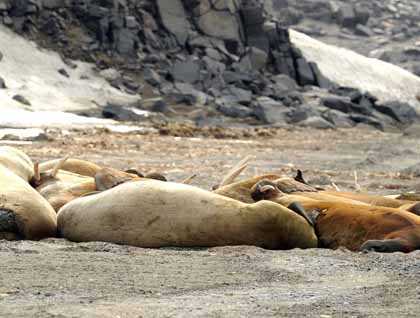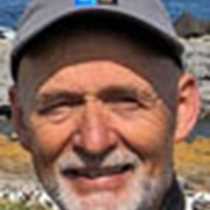After riding some windy waves around the southern tip of Spitsbergen (Sørkapp) we woke up to sunshine and calm seas in Storfjorden. We could see the east coast of Spitsbergen in the distance. After breakfast our Global Perspective Guest Speaker, Dr. Gregory Stone, gave an engaging lecture on how he became fascinated by the world´s oceans, to which he has devoted his entire professional life. Dr. Stone has been involved in a number of expeditions and deep-diving projects around the globe. In his presentation he showed some significant examples of major threats against the oceans, and what should be addressed to protect the oceans for future generations.
Just after the talk National Geographic Explorer encountered drift ice of growing density, and at 10:20 expedition leader Bud announced the first polar bear of the day. Eager guests equipped with binoculars and cameras appeared on the bridge and the front deck, and we managed to keep our voices to a whisper. An adult female bear could be seen feeding on the fresh kill of a ringed seal. As the ship gently approached, we discovered that the bear had a radio collar and also special marks in its ears. A small amount of the polar bears in Svalbard have been tagged by the Norwegian Polar Institute in order to find out how these bears move and migrate during the year.
Shortly after our first bear encounter a sow with a year-old cub was spotted on fast ice in the far distance. Lishawna Taylor, one of our Grosvenor Teacher Fellows, commented on how surprised she was to find out how far from the nearest shore these polar bears were observed. She said she now realized that the habitat of the polar bear is quite independent of the distance from the shoreline, as long as there is ice with seals to feed on. She also added that she loved being on the bridge and seeing how the officers, crew and expedition staff all cooperate to succeed with the various operations. “We navigate in very dangerous territory,” she said, “but as guests we have been told and prepared on clothing and operations so that we can thrive and learn without worrying about the special conditions we are facing this far north.”
After a shortened lunch break we had a digital photo session with photo instructors CT and Mike. Then we prepared for a landing on the western side of Edgeøya. We landed a short distance from an old trapper´s cabin at Kapp Lee where we got a chance to see a group of walrus males hauled out on the beach. Stefan, our beach master, was seeing that we all stayed quiet and moved no closer than 30 meters from the haul-out. Those guests who continued on hikes in the terrain above enjoyed the sight of various flowers in early bloom. A few purple sandpipers and snow buntings were encountered. Fairly short-distance encounters with Svalbard reindeer was one of the many highlights of the day. There was much to talk about during the evening recap, and the vivid humming of happy voices in the lounge gave proof of a very fortunate day of exploration.







